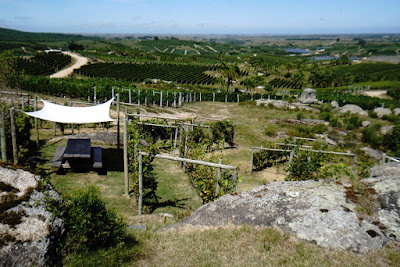Bodega Garzon is by far the largest Uruguayan winery with 200ha of vineyards, and with the most serious international ambitions. It is owned by a billionaire, and it shows. The vineyards are beautifully manicured and the buildings, opened in 2016, spectacular. In many ways, it reminds me of Craggy Range in New Zealand. Somebody comes in with a bold plan and the means to execute it. It is also an interesting example of what can be achieved with vines much less than 20 years old. Mr. Antonini of Italy has been a consultant for this project and is often involved in the selection and blending process.
Export manager Cecilia Curi and winemaker German Bruzzone take me through the tasting.
White wine is focussed on Albarino. The 2018 Reserve is clean, fresh, floral and fruity (88 points).The 2018 Albarino Single Vineyard is a step up. This wine is matured in tulips (eggs). 10,000 bottles are made. It has more intensity, more body and an oily texture. The mouthfeel is round and pleasing and there is vibrant energy through to the back palate (92 points).
The 2017 Pinot Noir Single Vineyard is of a soft style, with strawberry flavours dominant. It is a bit fruity for my taste (89 points). Can the combination of young fruit, 5000 plants/ha and 6-7t/ha yield really create a world class Pinot Noir? The 2017 Cabernet Franc Reserva has an attractive bouquet. This is a delicate wine, tasting of blue fruit, with silky tannins (92 points). The 2017 Marselan Reserva, a cross between Cabernet Sauvignon and Grenache, is an unknown to me. It has a deep purple colour, and is quite intense, but I find the flavour profile a bit simple. Minerality and acidity dominate the back palate (88 points).
After this, we come to the top bracket. The 2017 Tannat Reserva was picked quite late, due to the cooler conditions. The soil profile of porous granite worked well in this not so dry year. Flavours of plum and redcurrant deliver a good mouthfeel. The alcohol of 14.5% is well integrated. This is an elegant wine, with firm tannins which do not overwhelm (93 points).
My favorite Uruguayan Tannat turns out to be the 2017 Tannat Single Vineyard. It comes from a cool block in the vineyard. It has more depth and elegance than the Reserva, with black fruits dominating. This is a full-bodied wine at 14.5% alcohol, but it is neither fat nor hot on the palate. The mouthfeel is attractive, as the wine leads to firm tannins and minerality on the finish. This is a well balanced wine with a good future (94 points).
The top wine in the portfolio is the 2016 Balasto, referring to the porous granite soil in the vineyard. This wine is a blend of 45% Tannat, 25% Cabernet Franc, 18% Petit Verdot, and 12% Marselan. This wine has been matured in large barrels of untoasted French oak for 20 months. The Cabernet Franc provides welcome freshness to this very elegant wine. The flavours are of black fruits and the Tannat component delivers firm tannins. The grape varieties are well integrated; a wine of substance (95 points).
Bodega Garzon shows fantastic promise, given the young vines of this winery. It is interesting to note that this winery has chosen a Tannat blend as its signature wine. While I enjoyed the 100% single vineyard Tannat, it points to the fact that a blend can add some more interest and complexity to this difficult variety.
























